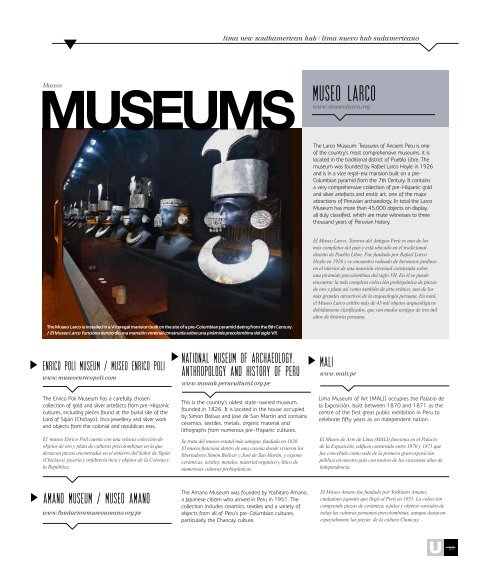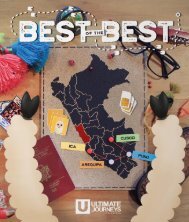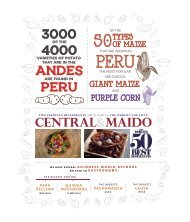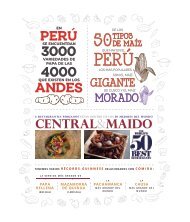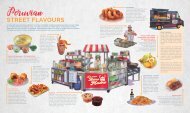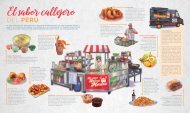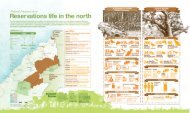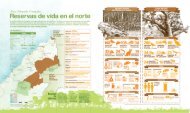Create successful ePaper yourself
Turn your PDF publications into a flip-book with our unique Google optimized e-Paper software.
lima new southamerican hub / lima nuevo hub sudamericano<br />
Museos<br />
MUSEUMS<br />
Museo Larco<br />
www.museolarco.org<br />
The Larco Museum: Treasures of Ancient Peru is one<br />
of the country's most comprehensive museums, it is<br />
located in the traditional district of Pueblo Libre. The<br />
museum was founded by Rafael Larco Hoyle in 1926<br />
and is in a vice regal-era mansion built on a pre-<br />
Columbian pyramid from the 7th Century. It contains<br />
a very comprehensive collection of pre-Hispanic gold<br />
and silver artefacts and erotic art, one of the major<br />
attractions of Peruvian archaeology. In total the Larco<br />
Museum has more than 45,000 objects on display,<br />
all duly classified, which are mute witnesses to three<br />
thousand years of Peruvian history.<br />
El Museo Larco: Tesoros del Antiguo Perú es uno de los<br />
más completos del país y está ubicado en el tradicional<br />
distrito de Pueblo Libre. Fue fundado por Rafael Larco<br />
Hoyle en 1926 y se encuentra rodeado de hermosos jardines<br />
en el interior de una mansión virreinal construida sobre<br />
una pirámide precolombina del siglo VII. En él se puede<br />
encontrar la más completa colección prehispánica de piezas<br />
de oro y plata así como también de arte erótico, uno de los<br />
más grandes atractivos de la arqueología peruana. En total,<br />
el Museo Larco exhibe más de 45 mil objetos arqueológicos<br />
debidamente clasificados, que son mudos testigos de tres mil<br />
años de historia peruana.<br />
The Museo Larco is installed in a Viceregal mansion built on the site of a pre-Columbian pyramid dating from the 8th Century.<br />
/ El Museo Larco funciona dentro de una mansión virreinal construida sobre una pirámide precolombina del siglo VII.<br />
ENRICO POLI MUSEUM / Museo Enrico Poli<br />
www.museoenricopoli.com<br />
The Enrico Poli Museum has a carefully chosen<br />
collection of gold and silver artefacts from pre-Hispanic<br />
cultures, including pieces found at the burial site of the<br />
Lord of Sipán (Chiclayo), Inca jewellery and silver work<br />
and objects from the colonial and republican eras.<br />
El museo Enrico Poli cuenta con una selecta colección de<br />
objetos de oro y plata de culturas precolombinas en la que<br />
destacan piezas encontradas en el entierro del Señor de Sipán<br />
(Chiclayo), joyería y orfebrería inca y objetos de la Colonia y<br />
la República.<br />
National Museum of Archaeology,<br />
Anthropology and History of Peru<br />
www.mnaah.perucultural.org.pe<br />
This is the country's oldest state-owned museum,<br />
founded in 1826. It is located in the house occupied<br />
by Simon Bolivar and Jose de San Martin and contains<br />
ceramics, textiles, metals, organic material and<br />
lithographs from numerous pre-Hispanic cultures.<br />
Se trata del museo estatal más antiguo, fundado en 1826.<br />
El museo funciona dentro de una casona donde vivieron los<br />
libertadores Simón Bolívar y José de San Martín, y expone<br />
cerámicas, textiles, metales, material orgánico y lítico de<br />
numerosas culturas prehispánicas.<br />
MALI<br />
www.mali.pe<br />
Lima Museum of Art (MALI) occupies the Palacio de<br />
la Exposición, built between 1870 and 1871 as the<br />
centre of the first great public exhibition in Peru to<br />
celebrate fifty years as an independent nation.<br />
El Museo de Arte de Lima (MALI) funciona en el Palacio<br />
de la Exposición, edificio construido entre 1870 y 1871 que<br />
fue concebido como sede de la primera gran exposición<br />
pública en nuestro país con motivo de los cincuenta años de<br />
independencia.<br />
AMANO MUSEUM / Museo Amano<br />
www.fundacionmuseoamano.org.pe<br />
The Amano Museum was founded by Yoshitaro Amano,<br />
a Japanese citizen who arrived in Peru in 1951. The<br />
collection includes ceramics, textiles and a variety of<br />
objects from all of Peru's pre-Columbian cultures,<br />
particularly the Chancay culture.<br />
El Museo Amano fue fundado por Yoshitaro Amano,<br />
ciudadano japonés que llegó al Perú en 1951. La colección<br />
comprende piezas de cerámica, tejidos y objetos variados de<br />
todas las culturas peruanas precolombinas, aunque destacan<br />
especialmente las piezas de la cultura Chancay.<br />
55


